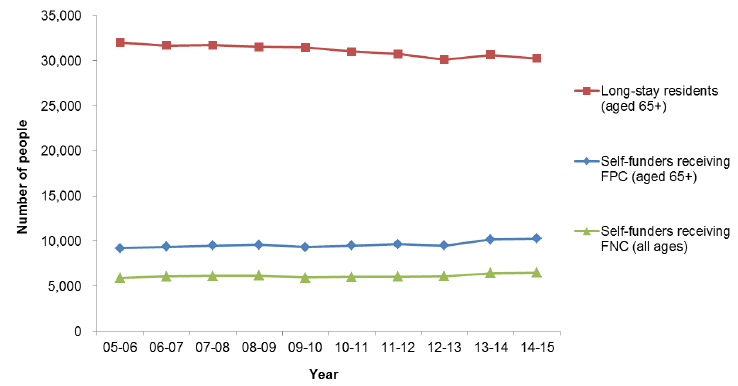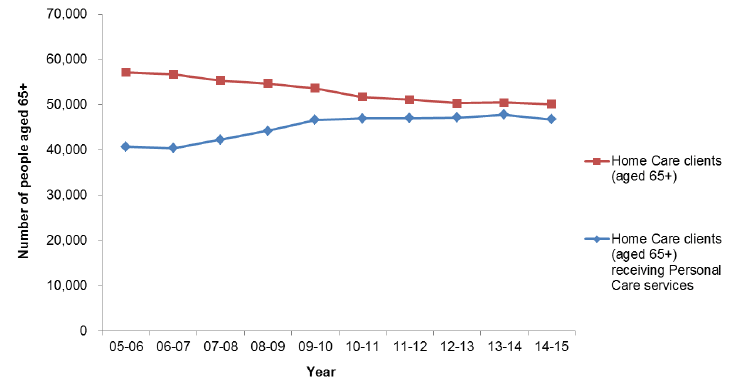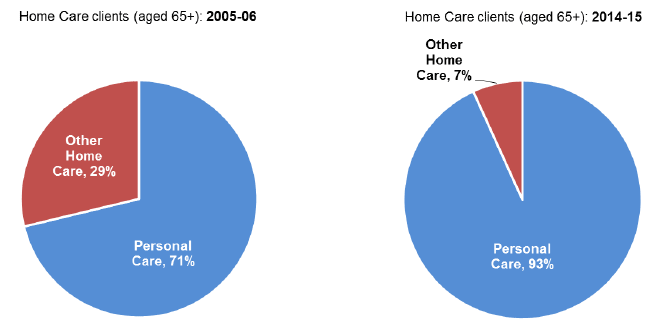Free personal and nursing care, Scotland, 2014-15
This Statistics Release presents the latest client and expenditure figures (financial year 2014-15) for Free Personal and Nursing Care (FPNC), which was introduced in Scotland in 2002. This release presents information from a variety of sources to give a picture of: the number of people that benefit from Free Personal Care and Free Nursing Care in Scotland; and the amount that Local Authorities spend on personal care services.
This document is part of a collection
2. People receiving Free Personal Care and Free Nursing Care
This section presents the latest available data on the number of people receiving Free Personal Care and Nursing Care in a Care Home and people receiving Free Personal Care at home.
2.1 Care Homes
Since 2002, information has been collected on the number of residents aged 65+ supported by local authorities in Care Homes. These residents may be mainly funded by their local authority or may be a self-funder receiving the appropriate weekly payment towards their Care Home fees. All of these residents receive personal care services for free.
Figure 3: Care Home residents, 2005-06 to 2014-15

Figure 3 (above) and Table 1 (over page) show that the average number of long-stay residents aged 65+ in Care Homes in Scotland has reduced slightly since the introduction of Free Personal and Nursing Care. In 2005-06 there were around 32,020 older people in Care Homes, which fell to 30,260 in 2014-15.
The number of self-funding Care Home residents who receive the FPC payment, in contrast, has risen over the time period. In 2005-06 there were around 9,190 self-funders receiving the FPC payment, which rose to 10,280 in 2014-15.
The proportion of long-stay residents who are self-funders follows a similar pattern, increasing from 29% in 2005-06 to 34% in 2014-15.
Over three-fifths (63%) of self-funding Care Home residents received the FNC payment in addition to the FPC payment in 2014-15, a figure largely stable since 2005-06. The number of self-funders receiving Free Nursing Care increased from 5,900 in 2005-06 to 6,500 in 2014-15.
Table 1: Care Home residents, 2005-06 to 2014-15
| 2005-06 | 2006-07 | 2007-08 | 2008-09 | 2009-10 | 2010-11 | 2011-12 | 2012-13 | 2013-14 | 2014-15 | |
|---|---|---|---|---|---|---|---|---|---|---|
| No. of long-stay residents (aged 65+) | 32,020 | 31,680 | 31,730 | 31,530 | 31,470 | 31,020 | 30,750 | 30,120 | 30,650 | 30,260 |
| No. of self-funders (aged 65+) receiving FPC | 9,190 | 9,380 | 9,510 | 9,580 | 9,330 | 9,490 | 9,660 | 9,480 | 10,180 | 10,280 |
| No. of self-funders (all ages) receiving FNC | 5,900 | 6,060 | 6,130 | 6,180 | 5,960 | 6,000 | 6,050 | 6,120 | 6,430 | 6,500 |
| Self-funders (aged 65+) receiving FPC as % of all long-stay residents | 29% | 30% | 30% | 30% | 30% | 31% | 31% | 31% | 33% | 34% |
| % self-funders (aged 65+) receiving FPC also receiving FNC | 64% | 65% | 64% | 65% | 64% | 63% | 63% | 65% | 63% | 63% |
Source: Community Care Quarterly Key Monitoring return.
All figures are yearly averages rounded to the nearest 10.
2.2 Home Care
Prior to 1st July 2002, people aged 65 and over could be charged for personal care services provided in their own home. Personal care services are now free, although individuals can still be charged for domestic services such as help with shopping or housework. Any charge would be subject to a financial assessment.
Figure 4: Home Care clients, 2005-06 to 2014-15

Figure 4 (above) and Table 2 show that the number of older people receiving Home Care services in Scotland decreased from 57,190 in 2005-06 to 50,160 in 2014-15. Over the same period, however, the number of Home Care clients receiving personal care services increased by 15% from 40,750 clients to 46,750. This increase occurred despite a slight fall in client numbers between 2013-14 and 2014-15.
The number of hours of personal care provided in Scotland increased from a weekly average of 259,600 hours in 2005-06 to 401,600 in 2014-15, a 69% increase. In line with the client figures, average weekly hours fell slightly between 2013-14 and 2014-15. The average hours provided per client each week has increased from 6.4 hours in 2005-06 to 8.6 hours in 2014-15.
Table 2: Home Care clients, 2005-06 to 2014-15
| 2005-06 | 2006-07 | 2007-08 | 2008-09 | 2009-10 | 2010-11 | 2011-12 | 2012-13 | 2013-14 | 2014-15 | |
|---|---|---|---|---|---|---|---|---|---|---|
| Home Care clients (aged 65+) | 57,190 | 56,700 | 55,340 | 54,720 | 53,660 | 51,730 | 51,120 | 50,370 | 50,450 | 50,160 |
| Home Care clients (aged 65+) receiving Personal Care | 40,750 | 40,410 | 42,260 | 44,200 | 46,660 | 46,950 | 47,010 | 47,170 | 47,810 | 46,750 |
| Average weekly hours of Personal Care at home | 259,600 | 272,900 | 299,400 | 333,100 | 361,700 | 371,900 | 389,000 | 400,500 | 409,500 | 401,600 |
| % Home Care clients (aged 65+) receiving Personal Care | 71% | 71% | 76% | 81% | 87% | 91% | 92% | 94% | 95% | 93% |
| Average weekly hours of personal care at home per person | 6.4 | 6.8 | 7.1 | 7.5 | 7.8 | 7.9 | 8.3 | 8.5 | 8.6 | 8.6 |
Source: Community Care Quarterly Key Monitoring Return 2004-05 to 2008-09, Home Care Census 2009-10 to 2011-12, Social Care Survey 2012-13 onwards.
Figures are rounded to the nearest 10.
Average weekly hours (based on last week of each quarter) are rounded to the nearest 100.
In recent years there has been a shift away from Care Homes towards more care being provided in people's own homes. Figure 5 shows that at the same time there has been an increase in the proportion of clients receiving personal care services. In 2014-15, 93% of all Home Care clients received personal care services compared with 71% in 2005-06. This increase is linked to the following National indicators:
- Improve support for people with care needs
- Increase the percentage of people aged 65 and over with high levels of care needs who are cared for at home
Home Care statistics are now published as part of the Social Care Survey. The latest figures, for 2014-15, are available from: http://www.gov.scot/Publications/2015/11/5804
Figure 5: Change in proportion of all Home Care clients aged 65+ receiving personal care, 2005-06 to 2014-15

Contact
Email: Steven Gillespie
There is a problem
Thanks for your feedback